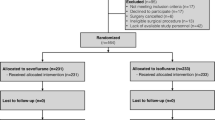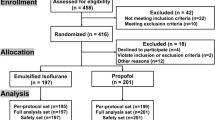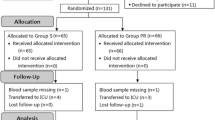Abstract
The selection of anesthetics for patients with myocardial infarction is critically challenging. Sevoflurane is a volatile anesthetic gradually used in recent years. The intraoperative hemodynamic stability of sevoflurane was supported by several studies with some suggestions for its use for patients with cardiac events. The present study was undertaken to investigate the effect of sevoflurane on mice with myocardial infarction to evaluate the safety issue of this agent for possible application in patients with myocardial infarction. Mice of 7–12 weeks old were subjected to left anterior descending artery ligation to introduce acute myocardial infarction. The effect of sevoflurane on the hemodynamics was examined in comparison with that of currently available agent etomidate at low and moderate doses. The results showed that sevoflurane caused unstable hemodynamic changes in mice with myocardial infarction at both low and moderate inhaled concentrations relative to low and moderate doses of etomidate. In addition, the relative safety margin estimated from therapeutic index was decreased by 50 % when sevoflurane was used for mice with myocardial infarction relative to control mice, but only decreased by 20 % for etomidate. These analyses indicate that in comparison with currently available agent etomidate, sevoflurane should not be applied to patients with myocardial infarction or other cardiac events.




Similar content being viewed by others
References
Djaiani, G. N., Hall, J., Pugh, S., & Peaston, R. T. (2001). Vital capacity inhalation induction with sevoflurane: An alternative to standard intravenous induction for patients undergoing cardiac surgery. Journal of Cardiothoracic and Vascular Anesthesia, 15, 169–174.
Clivatti, J., Smith, R. L., Sermer, M., Silversides, C., & Carvalho, J. C. A. (2012). Cardiac output monitoring during Cesarean delivery in a patient with palliated tetralogy of Fallot. Canadian Journal of Anesthesia/Journal canadien d’anesthésie, 59, 1119–1124.
Lee, H. M., Sung, H. S., & Kim, S. Y. (2011). Anesthetic management of non-cardiac surgery with adult onset type of cor triatriatum sinister -A case report. Korean Journal of Anesthesiology, 60, 444.
Rasmussen, K. G., Spackman, T. N., & Hooten, W. M. (2005). The clinical utility of inhalational anesthesia with sevoflurane in electroconvulsive therapy. The Journal of ECT, 21, 239–242.
Hallay, J., Micskei, C., Kollar, S., Sz Kiss, S., & Fulesdi, B. (2008). Anaesthesia of the myasthenic patients during thymectomy. Magyar Sebészet, 61(Suppl), 37–40.
Goodwin, N., Campbell, A. E., Hall, J. E., Plummer, S., & Harmer, M. (2004). A comparison of 8% and 12% sevoflurane for inhalation induction in adults. Anaesthesia, 59, 15–19.
Calderon, E., Torres, L. M., Aguado, J. A., De Antonio, P., Mora, R., & Almarcha, J. M. (1998). Comparative study of sevoflurane and nitrous oxide versus halothane and nitrous oxide in pediatric anesthesia: Efficacy and hemodynamic characteristics during induction. Revista Espanola de Anestesiologia y Reanimacion, 45, 126–129.
Walpole, R., & Logan, M. (1999). Effect of sevoflurane concentration on inhalation induction of anaesthesia in the elderly. British Journal of Anaesthesia, 82, 20–24.
Vidal, M. A., Calderon, E., Martinez, E., Pernia, A., & Torres, L. M. (2006). Comparison of 2 techniques for inhaled anesthetic induction with sevoflurane in coronary artery revascularization. Revista Espanola de Anestesiologia y Reanimacion, 53, 639–642.
Nathan, N., Vial, G., Benrhaiem, M., Peyclit, A., & Feiss, P. (2001). Induction with propofol target-concentration infusion vs. 8% sevoflurane inhalation and alfentanil in hypertensive patients. Anaesthesia, 56, 251–257.
Peacock, J. E., Lewis, R. P., Reilly, C. S., & Nimmo, W. S. (1990). Effect of different rates of infusion of propofol for induction of anaesthesia in elderly patients. British Journal of Anaesthesia, 65, 346–352.
Billard, V., Moulla, F., Bourgain, J. L., Megnigbeto, A., & Stanski, D. R. (1994). Hemodynamic response to induction and intubation. Propofol/fentanyl interaction. Anesthesiology, 81, 1384–1393.
Zouggari, Y., Ait-Oufella, H., Bonnin, P., Simon, T., Sage, A. P., Guérin, C., et al. (2013). B lymphocytes trigger monocyte mobilization and impair heart function after acute myocardial infarction. Nature Medicine, 19, 1273–1280.
Korf-Klingebiel, M., Reboll, M. R., Klede, S., Brod, T., Pich, A., Polten, F., et al. (2015). Myeloid-derived growth factor (C19orf10) mediates cardiac repair following myocardial infarction. Nature Medicine, 21, 140–149.
Eger, E. I, 2nd. (1993). New inhalational agents–desflurane and sevoflurane. Canadian Journal of Anesthesia/Journal canadien d’anesthésie, 40, R3–R8.
Dai, A. L., Fan, L. H., Zhang, F. J., Yang, M. J., Yu, J., Wang, J. K., et al. (2010). Effects of sevoflurane preconditioning and postconditioning on rat myocardial stunning in ischemic reperfusion injury. Journal of Zhejiang University Science B, 11, 267–274.
Deyhimy, D. I., Fleming, N. W., Brodkin, I. G., & Liu, H. (2007). Anesthetic preconditioning combined with postconditioning offers no additional benefit over preconditioning or postconditioning alone. Anesthesia and Analgesia, 105, 316–324.
Correia-Pinto, J., Henriques-Coelho, T., Magalhaes, S., & Leite-Moreira, A. F. (2004). Pattern of right ventricular pressure fall and its modulation by afterload. Physiological Research/Academia Scientiarum Bohemoslovaca, 53, 19–26.
Wallin, R. F., Regan, B. M., Napoli, M. D., & Stern, I. J. (1975). Sevoflurane: A new inhalational anesthetic agent. Anesthesia and Analgesia, 54, 758–766.
Kikura, M., & Ikeda, K. (1993). Comparison of effects of sevoflurane/nitrous oxide and enflurane/nitrous oxide on myocardial contractility in humans. Load-independent and noninvasive assessment with transesophageal echocardiography. Anesthesiology, 79, 235–243.
Bernard, J. M., Wouters, P. F., Doursout, M. F., Florence, B., Chelly, J. E., & Merin, R. G. (1990). Effects of sevoflurane and isoflurane on cardiac and coronary dynamics in chronically instrumented dogs. Anesthesiology, 72, 659–662.
Author information
Authors and Affiliations
Corresponding author
Additional information
Xiang Cheng and Jianglong Hou have contributed equally to this work.
Rights and permissions
About this article
Cite this article
Cheng, X., Hou, J., Liu, J. et al. Safety Evaluation of Sevoflurane as Anesthetic Agent in Mouse Model of Myocardial Ischemic Infarction. Cardiovasc Toxicol 17, 150–156 (2017). https://doi.org/10.1007/s12012-016-9368-9
Published:
Issue Date:
DOI: https://doi.org/10.1007/s12012-016-9368-9




